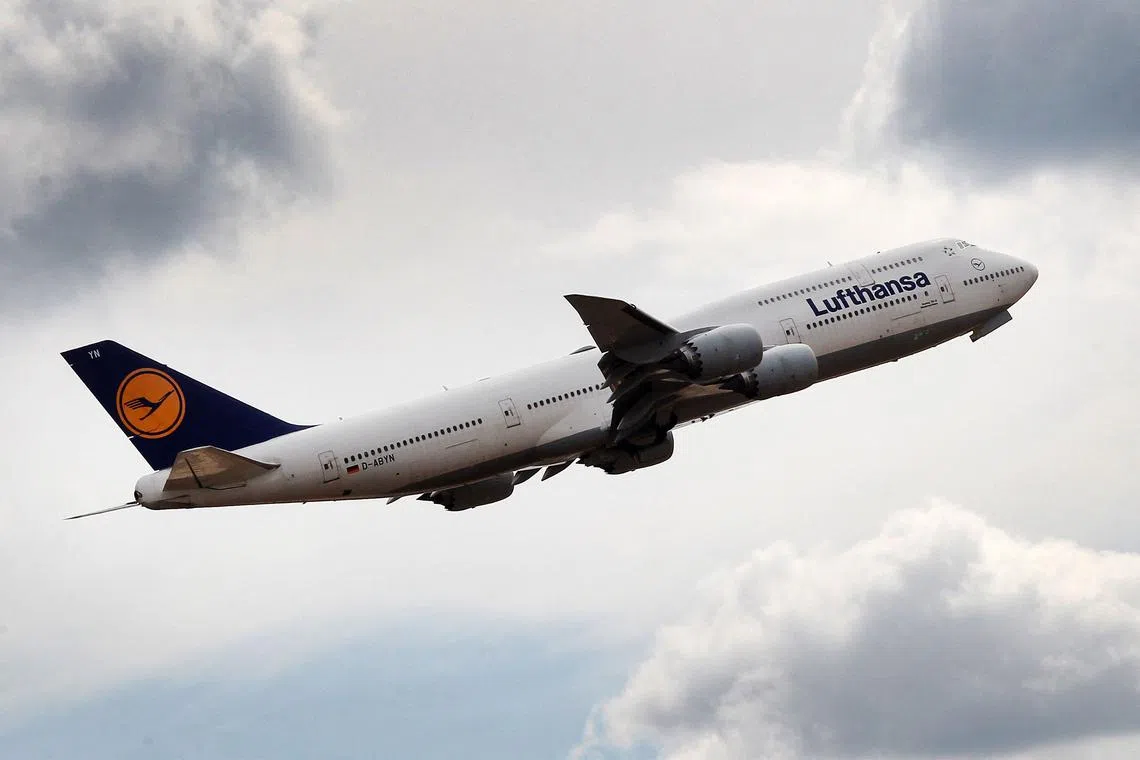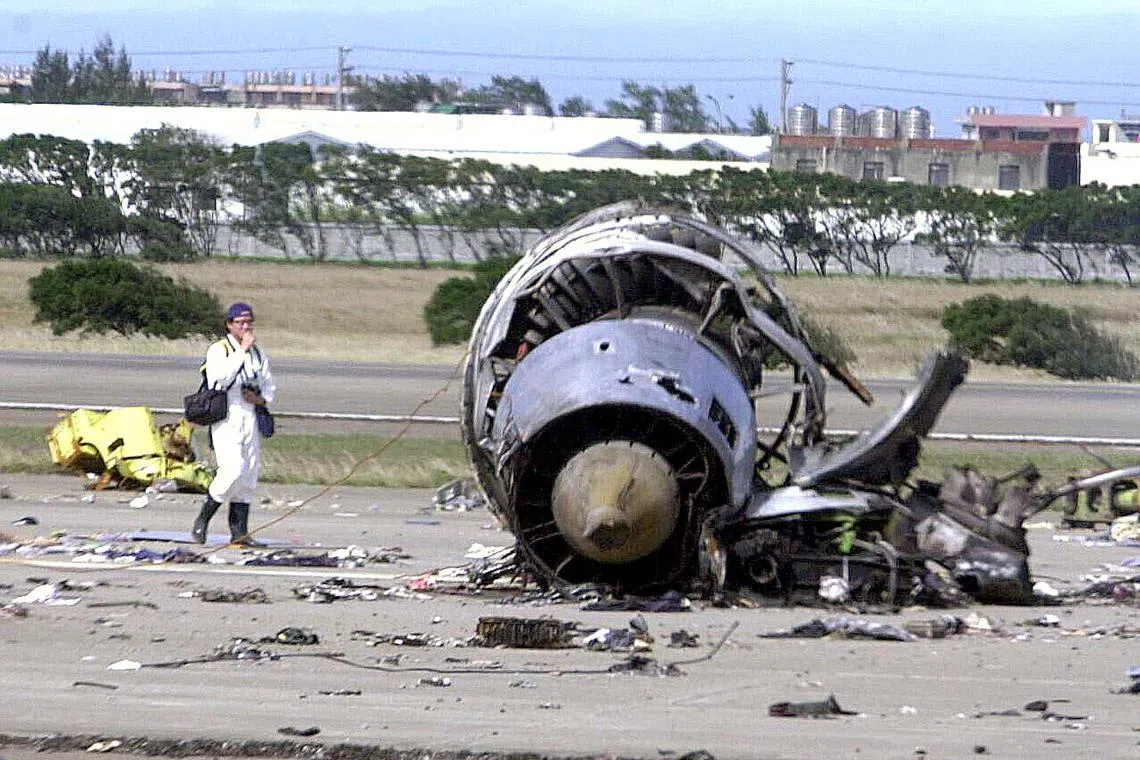Boeing's 747, the original jumbo jet, prepares for final send-off
Sign up now: Get ST's newsletters delivered to your inbox

A Lufthansa Boeing 747 at the airport in Frankfurt on Aug 1, 2022.
PHOTO: AFP
Follow topic:
SEATTLE/PARIS - Boeing’s 747 – the original and arguably most aesthetically pleasing “Jumbo Jet” – revolutionised air travel, only to see its more than five-decade reign as “Queen of the Skies” ended by more efficient twinjet planes.
The last commercial Boeing jumbo will be delivered to Atlas Air in the surviving freighter version on Tuesday, 53 years after the 747’s instantly recognisable humped silhouette grabbed global attention as a Pan Am passenger jet.
“On the ground it’s stately, it’s imposing,” said Bruce Dickinson, the lead singer of Iron Maiden who piloted a specially liveried 747 nicknamed Ed Force One during the British heavy metal band’s tour in 2016.
“And in the air, it’s surprisingly agile. For this massive airplane, you can really chuck it around if you have to.”
Designed in the late 1960s to meet demand for mass travel, the world’s first twin-aisle wide-body jetliner’s nose and upper deck became the world’s most luxurious club above the clouds.
But it was in the seemingly endless rows at the back of the new jumbo that the 747 transformed travel.
“This was the airplane that introduced flying for the middle class in the US,” said Air France-KLM chief executive officer Ben Smith. “Prior to the 747, your average family couldn’t fly from the US to Europe affordably.”
The jumbo also made its mark on global affairs, symbolising war and peace, from America’s “doomsday plane” nuclear command post to papal visits on chartered 747s nicknamed Shepherd One.
Now, two previously delivered 747s are being fitted to replace United States presidential jets known globally as Air Force One.
As a Pan Am flight attendant, Ms Linda Freier served passengers ranging from Michael Jackson to Mother Teresa.
“It was an incredible diversity of passengers. People who were well dressed and people who had very little and spent everything they had on that ticket,” said Ms Freier.
When the first 747 took off from New York on Jan 22, 1970, after a delay due to an engine glitch, it more than doubled plane capacity to 350 to 400 seats, in turn reshaping airport design.
“It was the aircraft for the people, the one that really delivered the capability to be a mass market,” said aviation historian Max Kingsley-Jones, who is the senior consultant at Ascend by Cirium.
“It was transformational across all aspects of the industry,” he added.
Its birth became the stuff of aviation myth.
Pan Am founder Juan Trippe sought to cut costs by increasing the number of seats. On a fishing trip, he challenged Boeing president William Allen to make something dwarfing the 707.
Mr Allen put legendary engineer Joe Sutter in charge.
It took only 28 months for Mr Sutter’s team known as “the Incredibles” to develop the 747 before the first flight on Feb 9, 1969.
Although it eventually became a cash cow, the 747‘s initial years were riddled with problems and the US$1 billion development costs almost bankrupted Boeing, which believed the future of air travel lay in supersonic jets.
After a slump during the 1970s oil crisis, the plane’s heyday arrived in 1989 when Boeing introduced the 747-400 with new engines and lighter materials, making it a perfect fit to meet growing demand for trans-Pacific flights.
“The 747 is the most beautiful and easy plane to land... It’s just like landing an armchair,” said Mr Dickinson, who also chairs aviation maintenance firm Caerdav.
The same swell of innovation that got the 747 off the ground has spelt its end, as advances made it possible for dual-engine jets to replicate its range and capacity at lower cost.
Yet the 777X, set to take the 747‘s place at the top of the jet market, will not be ready until at least 2025 after delays.
“In terms of impressive technology, great capacity, great economics... (the 777X) does sadly make the 747 look obsolete,” AeroDynamic Advisory managing director Richard Aboulafia said.
Nevertheless, the latest 747-8 version is set to grace the skies for years, chiefly as a freighter, having outlasted European Airbus’ double-decker A380 passenger jet in production.
This week’s final 747 delivery leaves questions over the future of the mammoth but now underused Everett wide-body production plant outside Seattle, while Boeing is also struggling after the Covid-19 pandemic and a 737 MAX safety crisis.
CEO Dave Calhoun has said Boeing may not design a new airliner for at least a decade.
“It was one of the wonders of the modern industrial age,” said Mr Aboulafia. “But this isn’t an age of wonders – it’s an age of economics.” REUTERS
A look back at the 747
Timeline
Sept 30, 1968: The first 747 is rolled out and displayed to the public.
Feb 9, 1969: The 747 undergoes its first test flight.
Jan 22, 1970: The 747 makes its first commercial flight, from New York to London.
June 28, 2014: The 1,500th 747 rolls off the production line.
July 27, 2016: Boeing discusses ending 747 production due to falling demand.
Dec 6, 2022: The last 747 rolls off the production line.

The last Boeing 747 leaving the company’s Everett factory ahead of delivery to Atlas Air in early 2023.
PHOTO: THE BOEING COMPANY/FACEBOOK
Disasters
March 27, 1977: Tenerife Airport disaster
Two 747s – KLM Flight 4805 and Pan Am Flight 1736 – collide in heavy fog on the runway of the airport on Tenerife, a Spanishisland in the Atlantic Ocean off the coast of Morocco, resulting in the deadliest aviation accident, with 583 deaths.
Jan 1, 1978: Air India disaster
An Air India Boeing 747 crashes into the sea off the coast of Mumbai on New Year’s Day, killing all 213 passengers and crew on board.
Sept 1, 1983: Korean Airlines disaster
On its way to Seoul from New York City via Anchorage in Alaska, Korean Airlines flight 007 is shot down by the Soviet air force near Sakhalin Island, killing all 269 passengers and crew on board.
Aug 12, 1985: Japan Airlines disaster
The deadliest single-aircraft accident unfolds with Japan Airlines Flight 123 crashing near Mount Takamagahara in Japan due to rapid decompression from a faulty repair, killing 520 of 524 passengers and crew on board.
Dec 21, 1988: Lockerbie bombing

An engineer examining the reconstructed remains of the Pan Am Boeing 747 jumbo jet which crashed into the Scottish village of Lockerbie nearly ten years earlier, on Dec 8, 1998.
PHOTO: REUTERS
All 259 passengers and crew are killed after a bomb planted on Pan Am Flight 103 explodes in midair over Lockerbie, Scotland.
July 17, 1996: TWA Flight 800 disaster
The Trans World Airlines flight, bound for Paris, explodes in midair shortly after take-off from New York, killing all 230 people on board.
Nov 12, 1996: Charkhi Dadri midair collision
Saudi Arabian Airlines Flight SV 763, a Boeing 747, collides with a Kazakhstan Airlines Ilyushin II-76 over the Indian village of Charkhi Dadri, killing all 349 people on both planes.
Aug 6, 1997: Korean Air Flight 801 disaster
Due to pilot error, the plane crashes into a hillside while approaching the island of Guam in the western Pacific Ocean, killing 229 people of 254 on board.
Oct 31, 2000: Singapore Airlines Flight 006 crash

The runway at Taipei’s Chiang Kai-shek airport and the wreckage of SIA 006 which crashed on the Oct 31, 2000.
PHOTO: ST FILE
The Boeing 747, bound for Los Angeles, crashes on a closed runway at Taipei’s international airport, killing 83 of the 179 people on board.
May 25, 2002: China Airlines Flight 611 disaster
The 747, bound for Hong Kong, breaks in midair soon after take-off and crashes into the Taiwan Strait, killing all 225 people on board. The cause was traced to metal-fatigue cracks from improper repairs 22 years earlier.
Pop culture references
• Airport 1975 (1974)
• Airport ‘77 (1977)
• Die Hard 2 (1990)
• Executive Decision (1996)
• Air Force One (1997)
• Casino Royale (2006)
• Argo (2012)
• Tenet (2020)

